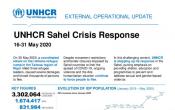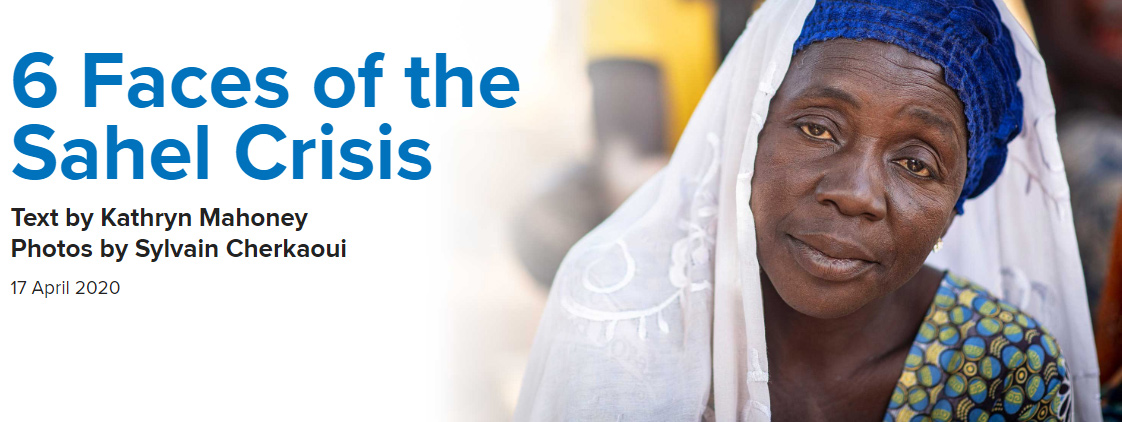Burkina Faso
Operation: Burkina Faso
Location
{"longitude":-2,"latitude":12,"zoom_level":0,"iso_codes":"'BFA'"}
By clicking on the icons on the map, additional information is displayed.
The boundaries and names shown and the designations used on this map do not imply official endorsement or acceptance by the United Nations.
Key Figures
| 2019 year-end results |
| 41,500 | IDPs and vulnerable host community members received shelter support |
| 3,200 | IDP households received cash-for-shelter and non-food items |
| 100% | of refugees were provided with individual documentation |
| 83% | of refugee children under 5 years old had their births registered by authorities |
| 57% | of refugees between 18-59 years old owned a business or had been self-employed for over 12 months |
| 50% | of IDPs assisted by UNHCR were provided with a valid identity document |
| 38% | of primary school-aged refugee children and 7% of secondary school-aged refugee were enrolled in education |
| 16% | of refugees with disabilities received assistance |
| 2020 planning figures | |
| 300,000 | newly displaced people will be registered to inform protection and assistance strategies |
| 130,000 | persons at risk of statelessness are provided with birth and nationality certificates |
| 49,000 | IDPs will receive transitional shelter support |
| 45,000 | vulnerable IDPs, including SGBV survivors, identified during protection monitoring will receive financial or material support |
| 5,000 | refugees with specific needs receive cash grants to enhance their self-reliance |
| 2,500 | refugee children enrolled in primary school |
| 1,500 | refugees receive production kits or inputs for agriculture/livestock/fisheries activities |
Latest Updates
People of Concern
712%
Increase in
2019
2019
| 2019 | 585,935 |
| 2018 | 72,195 |
| 2017 | 26,552 |

[["Refugees",25868],["Asylum-seekers",34],["IDPs",560033]]
Loading ...
Burkina Faso
< Back
2019
{"categories":[2015,2016,2017,2018,2019,2020],"budget":[20.5672092,21.67917582,24.785447776999998,24.650995690000002,30.51425102,75.66074024],"expenditure":[14.06340692,14.30327322,16.88336426,13.814450850000002,20.02836585,null]}
{"categories":[2015,2016,2017,2018,2019,2020],"p1":[20.5672092,20.97155543,24.274910527,24.147881350000002,18.03004102,24.21174559],"p2":[null,0.70762039,0.51053725,0.50311434,0.436361,0.379848],"p3":[null,null,null,null,null,null],"p4":[null,null,null,null,12.047849,51.06914665]}
{"categories":[2015,2016,2017,2018,2019,2020],"p1":[14.06340692,14.06146278,16.55595915,13.589716800000001,13.05374841,null],"p2":[null,0.24181044000000002,0.32740511,0.22473405,0.22207063,null],"p3":[null,null,null,null,null,null],"p4":[null,null,null,null,6.752546809999999,null]}
Loading ...
CHOOSE A YEAR
- 2014
- 2015
- 2016
- 2017
- 2018
- 2019
- 2020
Operational context
The humanitarian situation in Burkina Faso rapidly deteriorated in 2019, with attacks by unidentified armed groups intensifying and increasingly affecting civilian populations. As a result, the number of IDPs increased from 60,000 in January to a total of 560,000 as of early December.Limited humanitarian access as well as lack of funds for the humanitarian response presented major obstacles in implementing protection and assistance activities. The closure and/or overcrowding of social services in the country also exacerbated the vulnerabilities of people of concern.
Throughout 2019, UNHCR worked with the Government of Burkina Faso and other partners to continue to deliver protection and assistance, as well as to find solutions, for people of concern in the country. During the year protection monitoring and referral systems were strengthened, while regular registration and provision of documentation and identification to people of concern continued. Livelihood opportunities and durable solutions were also pursued. In June 2020, the Office declared an internal level 2 emergency to scale up its capacity to respond to the growing needs.
The Office also ensured that people of concern were included in development plans. As a result, refugees were explicitly mentioned as beneficiaries in the expanded Sahel emergency programme, the official reference document for the response to the emergency in the Sahel.
Despite growing insecurity and the deepening of the humanitarian crisis, the country continued to generously host Malian refugees. Some 730 new arrivals were registered in 2019, in addition to the over 24,700 Malian refugees already registered in the country.
Population trends
As of 31 December 2019, the population of concern in Burkina Faso was approximately 585,900, including 560,000 IDPs, 25,900 refugees (mainly Malian nationals) and 30 asylum-seekers. In addition, there were over 2 million people at risk of statelessness.In 2019, some 900 Malian refugees returned to Mali with assistance from UNHCR.
Achievements
- UNHCR met 26% of the shelter and core relief item needs for IDPs with specific needs.
- 90% of people at risk of stateless were identified in the census.
- 98,000 people at risk of stateless received civil status and identity documents.
Unmet needs
With the deepening of the crisis and multiple population movements, humanitarian needs continue to grow while operational challenges, such as the shrinking of humanitarian access due to insecurity, impacted the delivery of UNHCR’s programmes. In addition, with the operation funded at only 69% by the end of 2019, some needs remained unmet.- The extent of sexual and gender-based violence was greater than initially estimated. UNHCR worked with partners to ensure prevention and response activities, especially for IDPs. Nevertheless, underreporting and insufficient funds for income-generating activities for survivors constituted challenges to respond to these growing needs.
- Cases of trauma increased as a result of the crisis, requiring an expansion of psychosocial services.
- As the security situation disrupted schooling, more refugee teachers needed to be trained to make up for the unavailability of national teachers.
- In light of increased distrust between communities, additional activities to strengthen social cohesion were needed.
- As a result of the closure of markets, several refugees, especially women, lost their livelihoods. In a context of growing insecurity and limited opportunities, the adoption of negative coping mechanisms was a significant risk.
- Following several attacks, the security forces present in and around the Mentao refugee camps left the site in October 2019. Growing insecurity required UNHCR to relocate its staff out of the camp in November 2019, leading to sporadic access to refugees. Some services provided in the camps were closed, such as education (since December 2018) and health (since May 2019).
Operational environment
Rigorous security measures continue to result in the reduction of movements in the Sahel region in general and at the Malian border in particular. Relations between host populations and refugees in the Sahel region remain satisfactory and the Government of Burkina Faso shows continued willingness to accompany UNHCR in all initiatives aimed at improving the peaceful cohabitation and security of the camps and the host populations.The number of partners will be reduced in 2019 and focus will be on the rationalization of resources and maintaining efficient solutions-oriented services to refugees. UNHCR’s plan and activities in Burkina Faso in 2019 have been collectively elaborated and endorsed by all of the stakeholders, including partners, refugees, government parties, UN agencies and donors.
UNHCR continues to work closely with the Government of Burkina Faso through its National Refugee Commission (CONAREF) and National Emergency and Relief Commission (CONASUR). The Government of Burkina Faso continues to fulfil its obligations vis-à-vis protection for refugees and asylum-seekers.
UNHCR actively participates in the implementation of the current UNDAF 2018-2020, by integrating the priorities of refugees living in Burkina Faso and their needs. These priorities focus on protection, the expansion of access to national social services for refugees, the integration of camp health and school facilities into the national systems; the inclusion of refugees in local development programmes and the reduction of statelessness.
In 2019, the operation will continue to ensure that refugees are protected by the Government of Burkina Faso, live in safety and dignity with host communities, and progressively attain lasting solutions through the promotion of solutions oriented programming, emergency response to new arrivals, protection of people of concern in mixed migration flows and prevention and reduction of statelessness.
The promotion of the inclusion of refugees in the National Development Plan and the UNDAF will continue to provide an opportunity for UNHCR and development partners to initiate projects linked to the long-term aspirations of the refugees and host communities and thus ensuring sustainability. These activities will go a long way to create a favourable protection environment where refugees are able to achieve self-reliance.
Key priorities
UNHCR will continue enhancing Malian refugees’ legal and physical protection, giving priority to child protection and victims of violence. In addition to pursuing durable solutions, such as facilitated repatriation, UNHCR will also strengthen capacity-building, and access to livelihoods and income-generating opportunities through cash-based interventions.UNHCR will facilitate access to primary health care through its health services to reduce malnutrition rates. UNHCR will also strive to reinforce peaceful coexistence by granting host communities access to basic services.
As part of 2019’s priorities, UNHCR will initiate alternatives to camps and facilitate access to primary education. Finally, UNHCR will strive to address root the causes of statelessness by engaging key institutional actors at the national level.



















